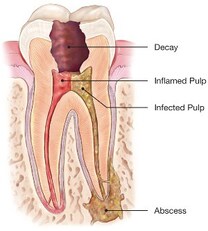Nothing feels, looks or functions as your natural teeth.Let's save your natural teeth together. Here at Endodontics of Maryland we use advanced treatments and materials to give you healthy and happy teeth.If you are nervous about having a root canal, we can set your mind at ease to help you have a comfortable, pain-free experience in our office.
What is root canal treatment?
|
The interior part of your tooth contains pulp, comprising of nerves and blood vessels, that lie in the roots of your teeth. This pulp can get infected or inflammed due to tooth decay, fracture or trauma. During root canal treatment, we carefully remove the pulp inside the tooth, clean, disinfect, shape the canals, and place a filling to seal the space.
Need a root canal? Don't be anxious. This informative page will walk you step-by-step through the procedure.Click here |
